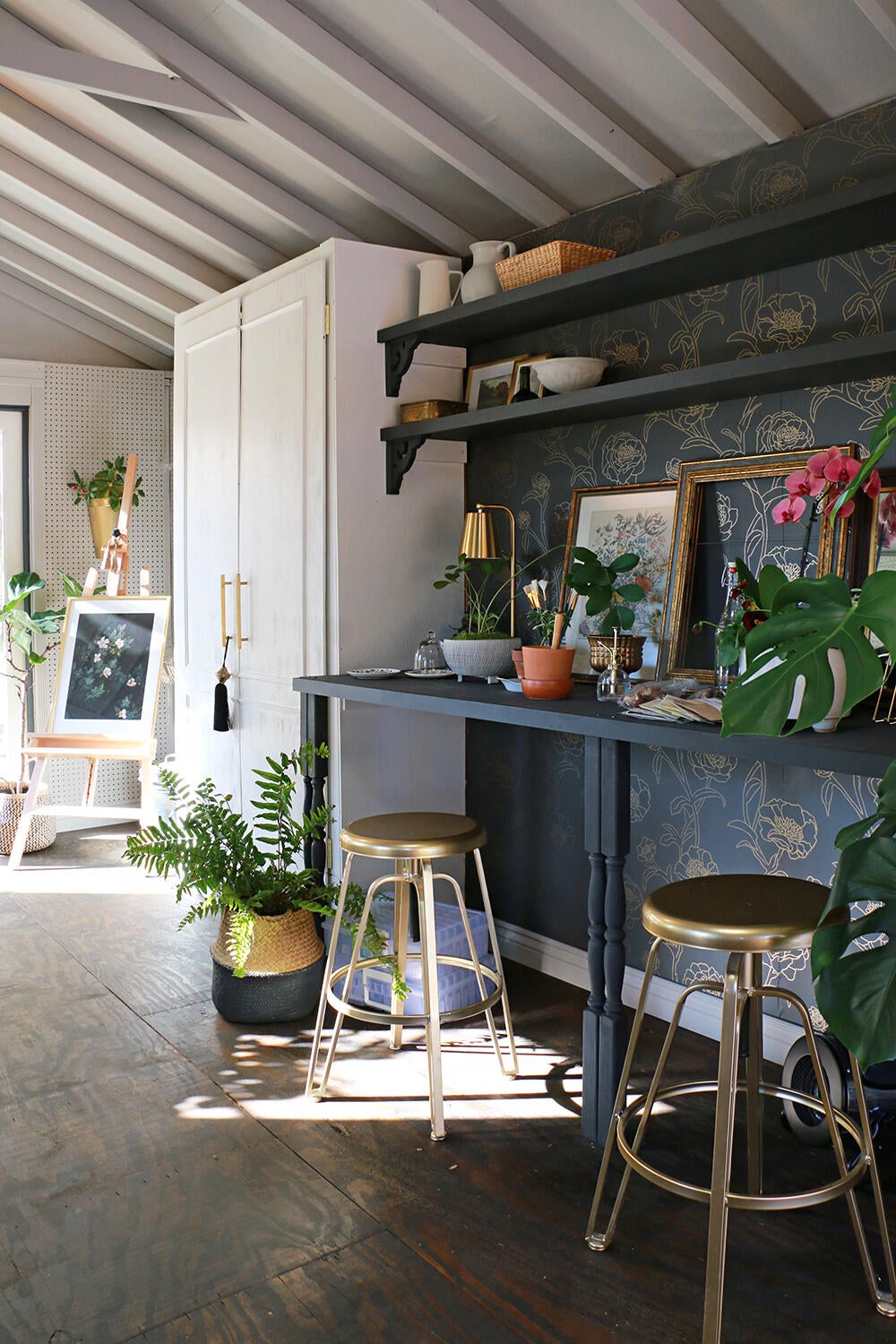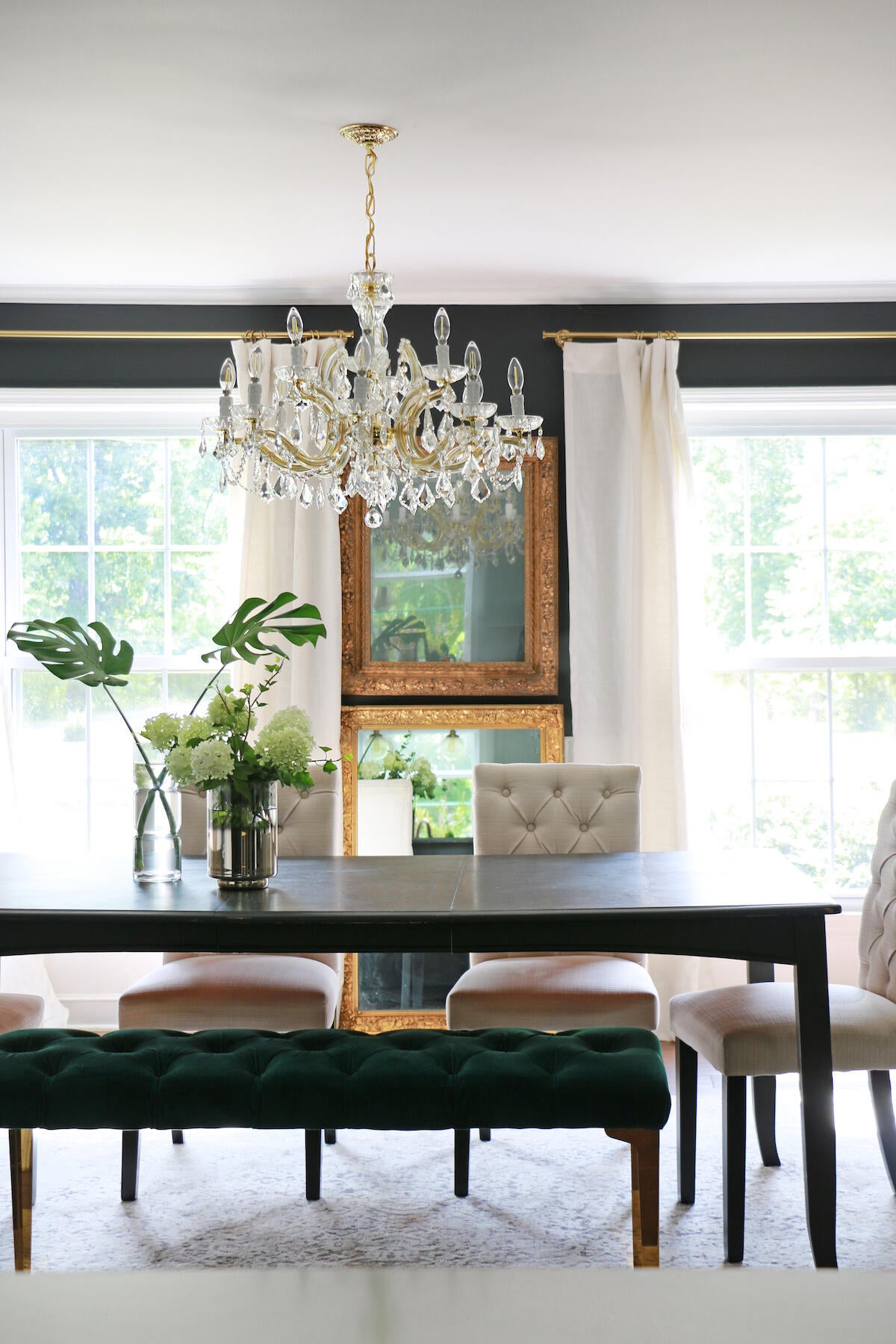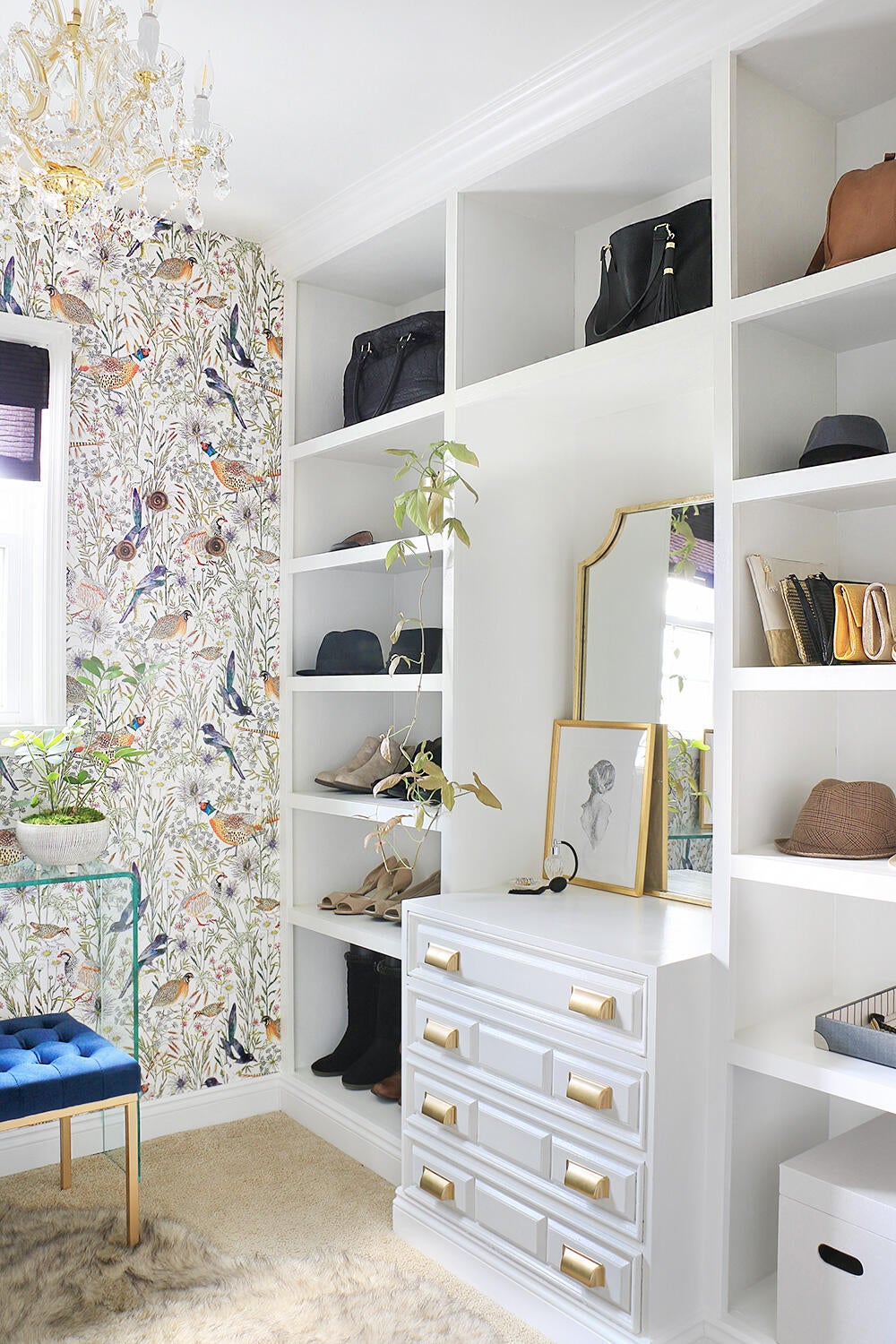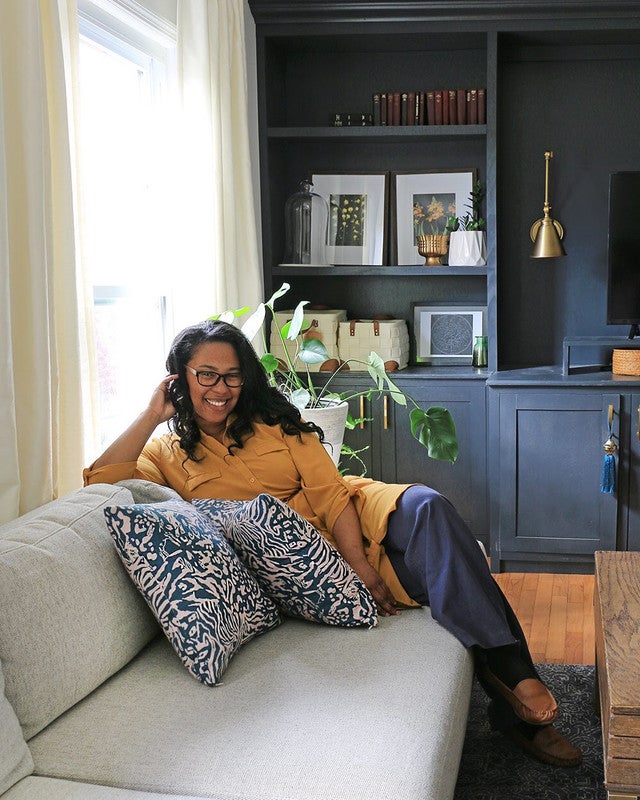In Ask an Influencer, Business of Home explores the creator economy. This week, we spoke with Ursula Carmona, the home and garden style expert behind Home Made by Carmona and Carmona Acres.
It was only a decade ago when Ursula Carmona first came across the world of design blogs. Back then, design was a side hobby as she homeschooled her three kids, looking for a way to tap into a larger community that shared her interests. Instagram was still new, and Carmona didn’t have a smartphone yet—even the word “blog” was a foreign concept to her.
“The first time I heard about [blogging about] things like design on a website, I thought, ‘What in the world is a blog?’” she says. But just as quickly, her outlook changed: “I ended up diving in right away—sharing little adventures, things that I learned, things that I did wrong in my home. It quickly resonated with people.”
One thing Carmona was ahead of the game on: setting out with the goal of making her budding blog a business. Her social media income (and budget) may have been at zero when she started blogging in 2012, but she knew that with a concentrated effort and consistent performance analysis, all that would change. Today, her home-centric Instagram account for Home Made by Carmona nets a following of 57,000, while her dedicated gardening account for Carmona Acres has 106,000 followers—all in addition to a variety of other media appearances, including a position as host of HGTV’s Table Wars: The Look for Less.
Ahead, Carmona shares why she spends more time in her DMs than she does posting content, best practices for getting your foot in the door with your favorite brands, and her step-by-step methodology for demonstrating professionalism in social media partnerships.

When did you first start approaching social media with a strategy?
The first thing I did was set some goals. It’s hard to do that when you don’t have a real understanding of what’s doable. You’re making it up as you go. I still have my goal spreadsheet where I put my one-, five- and 10-year goals. Some of those things I’ve met, and some of those things I’m like, ‘What was I thinking?’
It started off with little things: I remember the first year I finally got a smartphone. Everybody else had them forever but I could finally afford it—and my business could afford it because I refused to go into debt, so I wasn’t going to get a nice camera or smartphone until my business had money that I could reinvest. I’m not suggesting that’s the best way to do things, but that was just where I was in my life at that time. My other goals were things like sponsored content—creating content [in exchange] for products so I could start to build a portfolio. I listed each platform and exactly how many followers I was hoping to have in that year.
A lot of pivoting had to happen. Sometimes I would have these grand, unrealistic ideas of what I could accomplish in a year. That was OK because the first year went by and I thought, “OK, now I can [reevaluate and] see how much I can do. Now I can begin to project [my growth].” The funny thing is, the more you think you’ve got your finger on the pulse of something, the more everything is changing. Sometimes you have a harder time meeting [some goals], but then something skyrockets and you’re like, “Whoa, what just happened? How did this post just suddenly go viral out of nowhere?” One day it went from crickets to going viral and having 500,000 readers on my blog every month. But that [momentum] can be hard to re-create, so you have to be able to roll with that too.
How does your business function on social media?
Sponsorships have really been my bread and butter. I straddle the fence between design and DIY for the home. Among [creators] in DIY, I actually have a fairly small following on Instagram—if you have 50,000 followers or less, you’re not big. But even with a humble following, you can make a really good living with sponsored posts and brand deals.
A lot of people don’t realize just how much money there is in that market right now. Companies have realized the thing that has the greatest impact is now coming from someone who [makes] people [think], “I resonate with this person, and I love the things that they produce and I trust this individual.” It’s a lot of responsibility—it’s not something you should take for granted—but now brands are more and more willing to pay you for that. Understanding that you’re letting them into that trust you have with your audience can have a really big impact.
How do you work with brands?
I started by reaching out to brands whose materials and products I was already using all the time and saying, “Hey, I love this product.” When I didn’t have any real following, that was the opportunity to build my resume. You’re building that portfolio of work for other brands so that you can show them: “Hey, I worked with so-and-so, and now I’m asking for money.” It took a little while before I got to that point.
I don’t reach out to brands anymore. For the most part, my content calendar is too busy. But to get there, I had to prove my professionalism and that it was worth their while for brands to take a chance on me. Often, you’ll find that influencers or bloggers are sometimes hard to work with because they’ve got a lot on their plates. They’re doing a lot of things, and often the individuals who run marketing for the brands have to hunt them down. Don’t get me wrong–I’ve been guilty of these things too. But it’s the simple courtesies [of being on time and responsive] that can make a big, big difference.
Once you’ve worked with a few brands—especially those that are a little more established or bigger—other companies will see you and start reaching out. These days, they hire their marketing out to teams and third-party companies that handle all their brand management. So I work with the company that handles the marketing for such-and-such brand, and I will say, “I noticed that you also work with this brand over here. If you’ve enjoyed what I’ve produced for you, then maybe we can work together on that brand too.” If you’re easy to work with, they will always come back to you. Often they work with multiple companies, and that’s your opportunity to see if you [can work with] another company or if they want to pass your name on to their co-worker who works with that company. [You can say something like,] “I am really interested in that brand because I use that product at home. I love it. I can get behind it.”

What does that professionalism look like in practice?
Being really creative with the content that you create, and prepitching ideas for them. Sometimes you have to go the extra yard. My methodology is simply this: Either I let them know in advance—so I send out my media kit—or when a brand reaches out to me, I will immediately let them know what my starting rates are, first thing off the bat, so that we’re both on the same page.
I let them know that I’m going to take this seriously, that I’m going to set aside time to create the content. It’s not going to be rushed, and we’re going to spend a couple months in advance on all the back-and-forth emails and negotiations happening behind the scenes. But beyond that, I let them know: “I’m going to take time on the content that I’m creating for you to make sure that we get it right before it’s ever published.” So I will present to them a preview of what I’m going to be putting together for them. Then they get to go through it, look at it, see what kind of edits they want, and we’ll go back and forth.
Then after that, I provide analytics. That’s a nice, handy little write-up that shows how that post is doing, how many people it’s reaching, how I’m promoting it, and the ways I’m finding to try to give it the organic boost. It all boils down to being on time with your deliverables, giving them a schedule in advance and making clear expectations of, “Hey, I expect you to get me the product by a certain time. I will produce this outline for you by such-and-such a date. And then you’ll have content to preview by this date, and then I expect payment on this date.”
How do you set your rates?
That’s been a challenge. I’m a bit of a people-pleaser; I don’t want to be confrontational. The struggle has always been that I’ve undervalued my work in the past, but my husband is very much the opposite. He knows the art of negotiation. He’s been the voice behind me, saying, “That’s not enough.” I would drag my feet, but here’s the thing: Sometimes you have to test the waters to find out exactly how much you can ask for. There would be times when I would say, “OK, how badly do I want to do this project? I’ve got a lot going on. I will double my rate, and if they come back and say yes very quickly, then the next time we have this situation, I’ve got to go higher than that.” That has helped me [determine] how much I can ask for. That’s in addition to making sure that I’m careful about the expenses for production, and how much my time is worth—basically, how many hours go into this product or this project?
I think to myself, a lot of times, if you’re an individual, you’re acting as your own camera crew, your own copywriter; and if you’re a DIYer, you’re the handyman, the contractor. So you start to ask yourself, “What does that price tag look like?” And if a company were to pay for a production team to do this, what would that look like? Here’s the reality: Those are the kinds of dollars that they pour into their marketing, so why not?
For designers, it’s interesting because the design world works a little bit differently. They’re already creating content for their social channels; they’re already putting stuff out there and sometimes they’ll have a team. If you already have someone who you’re paying to do things for your social media, or if you’re doing it yourself, why not capitalize on some of this? You’re already going to be creating this content, so where else can this content live? How else can this content make money? We have to talk about monetizing our platforms. I always think to myself, “If I’m going to take the time and effort to create a video, why am I not just automatically posting it to every platform?” I know that not every platform will take as well to that, and sometimes you have to customize things to the platform, but hey, it’s out there. You never know where it’s going to go. When I create something, it’s uploaded to Instagram, TikTok, YouTube Shorts, and it’s probably also on Pinterest, which now supports video. If you find that you start to do well on a particular platform, that’s where you can really start to make that extra money in addition to working with sponsors.
What’s the strategy behind the content you post?
My philosophy is about creating a home that you love to live in, where it’s not just about style—it’s also about creating the life that you want. Because of that, it’s very practical. I hope that all of the content that I produce helps people accomplish their goals. I always tried to do things a little more polished, but I’m learning that that’s not entirely necessary. Sometimes you can just be who you are in your own home and showcase something that has worked beautifully for you, and explain why it works. That will resonate with people. Don’t get me wrong, I’m looking for beauty and inspiration, but at the end of the day, we all have similar struggles, and if we can find ways to connect and help each other, that’s [a sweet spot] for me. I’m always thinking of that person who’s out there trying to find solutions, discouraged with what they have, wanting to accomplish something and willing to put in the time and effort.

What does the physical process of producing content look like for you?
I always joke that it looks crazy because about six years ago or so, I bought fancy camera equipment and all that stuff—and wouldn’t you know, with almost all my content, I use my iPhone, some great natural light whenever possible and a tripod. It’s amazing that you can create content these days without having to spend the big bucks. And sometimes it’s just a matter of having to dial in or learn how to use the fancy equipment that holds some of us back. I’ve mostly relied on my iPhone to create, and I use Adobe Premiere Rush to edit, and it’s all right on my phone.
How much of yourself do you show on social media?
I don’t do a lot of personal stuff. Stories have never really been my thing. It’s just not really who I am. But the interesting thing is, as far as being the face of my brand, that’s part of what my brand looks like. Because I tend to show people how to do things themselves, I want them to see that it’s doable. I want them to see that I didn’t hire somebody else to come in. I think that that helps people identify and recognize it’s a doable project. I’m not saying that everybody can do everything everyone else can do, but I am saying that my message is always to try something that makes you a little uncomfortable. You have to learn how to grow your skills if you want to have this outcome. In that case, I think it’s important that they see that I’m the face, but I’m not just the face—I’m actually doing these things.
Do you respond to comments and DMs?
That’s always a fun adventure. I think sometimes people forget that there’s a human behind the platform or the brand. You can get some interesting comments once in a while. But you also end up building a truly beautiful community. I’ve learned that when someone says something hateful, that community very quickly rises to your defense and you don’t have to say a word. Which tells me that an important part of building your community is commenting back and forth and sharing. I have people who will send me messages showing me what they’ve created, and I always get excited with them. I love the community that it creates. Because sometimes it can be hard to find those people who understand what makes you excited and resonates with you, so when we have that opportunity to lift one another up and encourage one another, why not do that? I think it’s really important. I probably spend more time in my DMs than actually posting, as crazy it sounds.
Does keeping up with social media ever get overwhelming for you?
I’ll be honest, social media is a mixed bag. It’s what we make of it, but sometimes it can be a bit sad because there can be a lot of criticism. There can be a lot of comparisons. It can be one of those things that you fall into and then discover that you’re not actually living your life, and I’m really cognizant of that.
The last couple years have been a huge step back from, “I’m posting every single day, I need to increase my followers.” I thought the money was in the followers, and that that was a sign of success. But I’m learning that there’s more to it than just the numbers and not to get so hung up on that. Even on the mental health side of things, I’m thinking, “OK, how much time am I spending doing this, and how much time am I spending creating things just for me?” I have no problem stepping back—it’s all going to still be there. I usually feel a lot more renewed when I come back, and I get an influx of messages from people saying, “We’re so happy you’re back!” That’s speaking to that community—they lift me up and encourage me as much as I hope that I do the same for them.
What’s the biggest challenge for you on social media right now?
You can feel like, “This is a constant, uphill climb and I’m running in place. When am I going to get to the top of the hill?” What’s funny is when you do reach a goal—like when I first hit 20,000 followers on Instagram—I was expecting to be so excited because I had worked for a few years to get to that point. And then I got there and I didn’t even care. I was looking at the next goal. I had a hard time just being in the moment and celebrating the achievement. It was at that point that I went, “No, this isn’t going to work.” I need to be able to not just chase followers, but also ask myself: “What’s the return on my investment?” Instead, it became about creating quality over quantity and asking myself, “How can I create a community?”
You can have a million followers, but what are they getting out of it? Is it worth the return on their investment timewise? Are they taking joy away from it? Are they sharing their passions? We get so caught up in the follower numbers that we don’t ask that question. You’ll start to see that the growth happens organically when you change your mindset.
Homepage image: Ursula Carmona | Courtesy of the designer





























